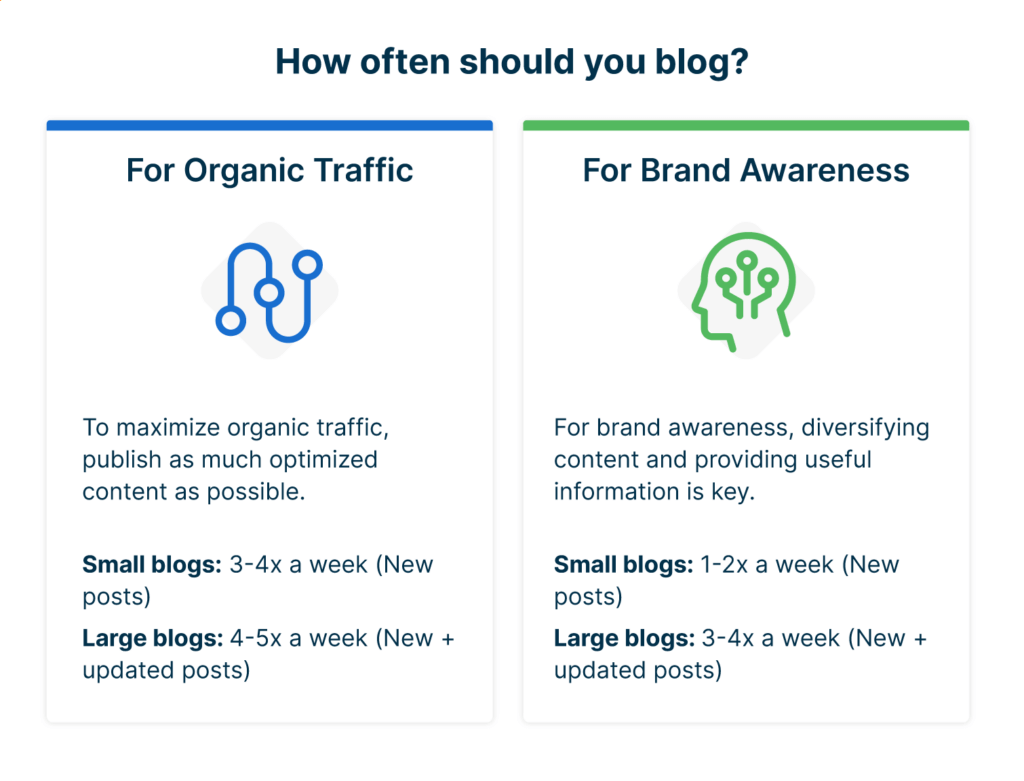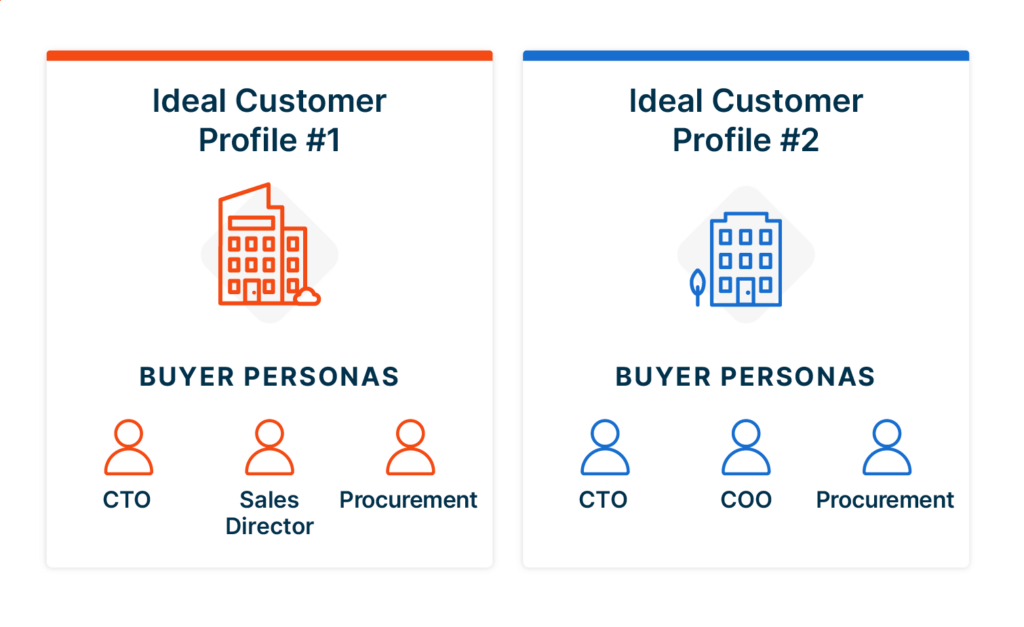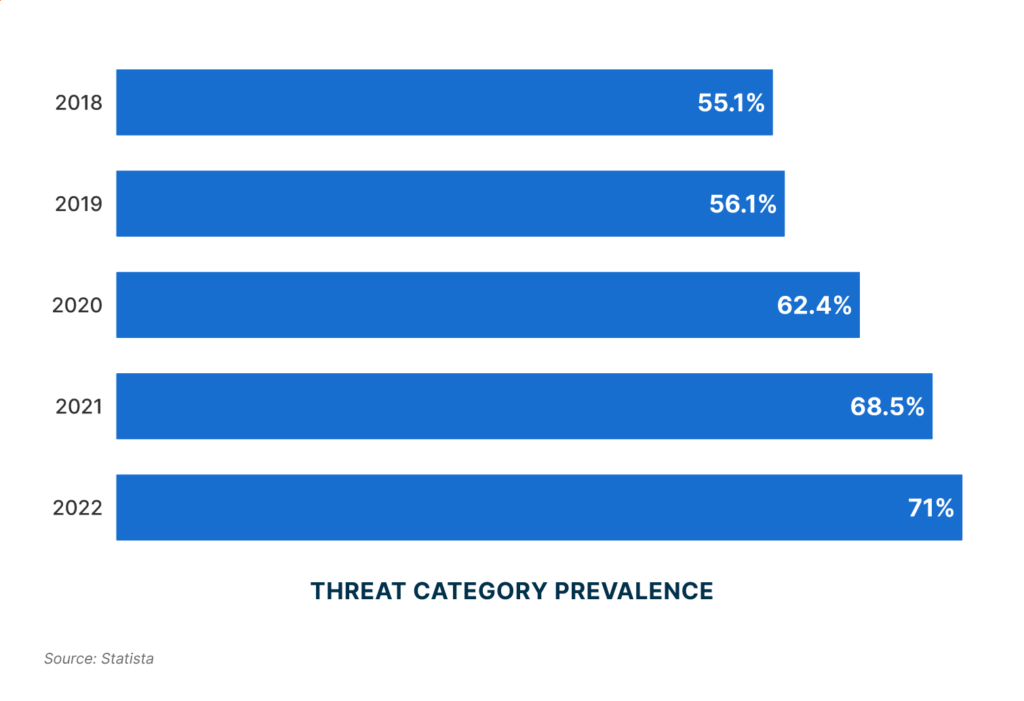Cybersecurity content marketing is unique—it requires the same best practices as any other content marketing, but with the added need to educate audiences on a highly technical topic that’s critical to their business but often challenging to understand.
The good news is that the need is massive for cybersecurity services—40% of executives rate cyberthreats as their No. 1 business risk, according to a recent survey by PwC.
With the right strategies in place, cybersecurity firms have a significant opportunity to leverage content to grow their pipeline with high-potential leads. In this guide, we’ll walk through five ways cybersecurity marketers can level up their content efforts to boost ROI.
Quick Takeaways
- For maximum content marketing ROI, companies should be publishing multiple times per week across several channels
- It’s critical to target content to individual customer segments and needs
- Cybersecurity content marketers should aim to create urgency with buyers but never to instill fear (which can kill customer trust)
- Companies can establish their position as an industry expert by publishing content that features in-house SMEs and providing original insights on industry trends and events
- Using real-world examples makes cybersecurity content relatable to buyers
5 Tips for How To Ace Content Marketing for Cybersecurity
Publish Consistent Content Across Channels
Content marketing strategies in every industry—cybersecurity included—need a consistent and high-volume publishing schedule in order to drive traffic and convert leads. According to HubSpot, for example, companies should be publishing blogs multiple times per week in order to see optimal results.

Content should also be amplified in other places. McKinsey reports that B2B buyers use 10 or more channels to interact with providers (a number that’s more than doubled since 2016) and failing to leverage these channels can lead to missed opportunities for marketers.
As you develop your cybersecurity content marketing strategy, be sure to include the following important elements:
- A detailed publishing schedule that includes content deadlines, publish dates, and persons responsible for executing specific tasks
- Plans for sharing content across channels—for example, sharing blog posts on social media or including videos in an email nurture campaign
Target by Customer Segment
Every company needs cybersecurity, but not for the same reasons. To nail your content strategy and boost its ROI, define and target your content to individual customer segments. This starts with knowing your own audience, and there are two frameworks that can help you do it: ideal customer profiles (ICPs) and buyer personas.
The former outlines the organizational characteristics that define your best-fit B2B customers (think industry, company size, budget, and IT maturity). The latter describes the decision makers within those companies who decide on providers and solutions.
Here’s a helpful visual to demonstrate the relationship between the two:

Once you know your ICPs and buyer personas, use SEO to learn what they’re searching for and align your content topics and themes accordingly. Aim to demonstrate an understanding of the unique needs of each segment and deliver content that directly addresses their pain points.
You can also expand into new and large audiences that fit your ICP by creating innovative content outside of the most commonly used channels (i.e. blogs, social media, email, and so on)—for example, multi-vendor tech webinars (like the ones we host at ActualTech Media) give you a chance to speak alongside other industry experts and show engaged buyers why your brand is a top choice.
Create Urgency, but Not Fear
Cybersecurity events like data breaches and ransomware attacks are prevalent and costly—IBM reports that the average cost of a data breach in 2022 for U.S. companies was $4.35 million, and a staggering 83% of companies it surveyed had experienced more than one breach. Statista found that 71% of organizations worldwide experienced a ransomware attack last year—up 15% from 2020.

The point: Without the right cybersecurity measures in place, companies are at massive risk. It makes sense, then, to lean on this urgent need for lead generation and to motivate conversions—but it’s also important to strike the right balance.
The best approach for cybersecurity content marketers is to create urgency without using scare tactics or instilling fear. Going overboard to frighten potential customers into buying can actually do the opposite, causing you to lose trust with your audience so that they look elsewhere.
Buyers want to work with cybersecurity providers who are honest about existing risks and able to demonstrate how their solution can deliver valuable results. Let the numbers speak for themselves, then, when it comes to highlighting risk, and focus on positioning your brand as the best choice for eliminating them.
Be the Expert
Buyers always want to work with providers who are experts in their fields—after all, companies hire solution providers in the first place because they don’t have the knowledge, resources, and products to solve a problem in-house.
But expertise is even more essential for cybersecurity providers given the mission-critical nature of the services they deliver and the seriousness of the risks they eliminate.
Ensure that your cybersecurity content marketing strategy showcases your brand as a thought leader in your industry. A few effective ways to do this include:
- Cover topics for which you have the most expertise
- Provide original insights—don’t shy away from providing your own expert commentary on prominent issues or industry events and trends
- Feature subject matter experts within your organization
- Showcase your success by telling client stories
- Participate in multi-vendor webinars, where you can talk alongside industry peers about topics your target audience cares about
Use Real-World Examples
Until a company experiences one itself, cybersecurity threats can seem like one of those things you hear about a lot, but that never really happens to you. This can be a barrier to buyers making the investment in cybersecurity services they truly need.
There are plenty of real-world examples you can use to humanize cybersecurity threats and make them relatable to your buyers. Share client stories and commentate on news about real cybersecurity events to do this, and focus on the people involved in the breach to drive the human element home.
For example, in July 2022, a cloud misconfiguration led to thousands of airline employees’ personal information being exposed, compromising their individual safety and flight security for the airline. Emphasizing the impact on airline employees (rather than just the more abstract story) can be what really gets a prospect’s attention and creates motivation to buy.
These kinds of current-event stories and real-world cybersecurity compromises are perfect topics for webinars and other thought leadership content—they’re already in the news, probably have gotten your audience’s attention, and give you an opportunity to provide expert commentary on how it could affect them in similar ways.
Similarly, sharing client stories with leads in your sales pipeline from the same industry or who have other shared needs can help them see how your solutions are valuable in real-world scenarios.
The goal should always be to make it easy for buyers to put themselves in the shoes of another company and imagine how things would play out if it were their organization.
The 2024 Cybersecurity Buyers Report
In late 2023, ActualTech surveyed it's extensive audience of Cybersecurity Buyers to find out what makes them tick. We wanted to get into the weeds to learn more about their buying cycles, budgets, messaging that resonates and more. We then published the results along with our partners at the Cybersecurity Marketing Society in the Cybersecurity Buyers Report. Click the link to grab your complementary copy.
Get Your Cybersecurity Solution in Front of Motivated Buyers
ActualTech Media’s multi-vendor webinars can position your company as a leader alongside peers in your field and help you generate 200 to 1,200-plus high-quality leads for your pipeline.
You choose the topics and events you want to participate in, and we do the rest—attracting attendees, moderating the event, and providing you with lead data afterward.
Get in touch with our team today to learn more about how we can help you grow your business.